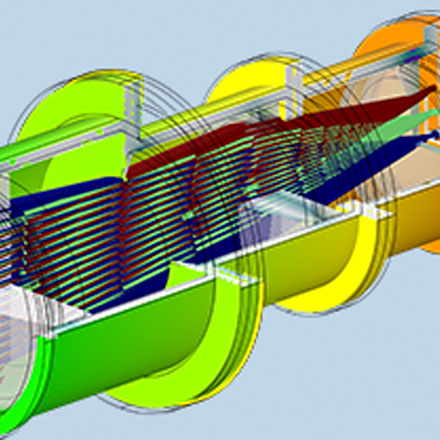|
Wednesday, April 28, 2021 |
|
Join us for a FREE Webinar
Improving the Design of Optical Devices Through STOP Analyses
Wednesday, May 12, 2021 2:00 PM - 3:00 PM EDT
|
|
Presented by
|

|
|

|
There is an ever-increasing interest in structural-thermal-optical performance (STOP) analysis for optical systems, in which temperature change and structural loads affect the optical performance. The need for STOP analysis is greatest for extremely high-power systems, those in extreme operating environments, or those in which highly accurate predictions are vital. Examples include industrial fiber laser systems, space-based laser interferometers, balloon-based telescopes, and solar thermal desalination systems.
A high-fidelity STOP analysis must consider the different pathways by which temperature changes affect optical performance. Most materials have temperature-dependent refractive indices. In addition, thermal stress may contribute to structural deformation alongside other applied loads such as gravity. If the optics themselves are the heat source, as in high-power fiber laser systems, the STOP analysis may require a bidirectional coupling in which the energy dissipated by the optics acts as an additional heat source in the thermal analysis.
Developing accurate solutions for STOP analyses requires multiphysics simulation software and the expertise to develop these simulations. In this presentation, guest speakers Kyle Koppenhoefer, Ph.D., and Joshua Thomas from AltaSim Technologies will join Christopher Boucher of COMSOL to discuss the development of STOP solutions for optical devices. The webinar will also include a live demo in the COMSOL Multiphysics® software and an open Q&A session.
Pictured: Model of a STOP lens. Courtesy of AltaSim Technologies.
Who should attend:
- Laser engineers.
- Optical design engineers.
- AR/VR researchers.
About the presenters:
Christopher Boucher is the technical product manager for the Particle Tracing Module and Ray Optics Module from COMSOL. He received his B.S. degree in aerospace engineering and physics from Worcester Polytechnic Institute before joining COMSOL in 2012.
Kyle Koppenhoefer, Ph.D., is president and co-founder of AltaSim Technologies. He works with customers to identify how computational analysis can be used to provide solutions to their products and manufacturing processes. Prior to co-founding AltaSim, he worked for the Department of Defense and the Edison Welding Institute. He holds a doctorate in civil engineering from the University of Illinois.
Joshua Thomas has provided consulting and training support in COMSOL Multiphysics® over the last six years as a research engineer at AltaSim Technologies. He is a lead instructor in many of AltaSim’s classes and has worked extensively with structural mechanics problems and multiphysics problems that include structural mechanics. Thomas received his bachelor’s and master’s degrees in mechanical engineering from The Ohio State University.
To learn more about AltaSim Technologies, visit www.altasimtechnologies.com.
About COMSOL Inc.:
COMSOL is a global provider of software solutions for multiphysics modeling. Its COMSOL Multiphysics® product is an integrated software environment for creating physics-based models and simulation apps. Add-on products expand the simulation platform for electrical, mechanical, fluid flow, and chemical applications. Interfacing tools enable the integration of COMSOL Multiphysics® simulations with all major technical computing and CAD tools on the CAE market. Simulation experts rely on the COMSOL Server product to deploy apps to their design teams, manufacturing departments, test laboratories, and customers throughout the world.
**Please see www.comsol.com/privacy for COMSOL’s privacy policy. Contact COMSOL at www.comsol.com/contact for more information. Note that COMSOL will follow up with all registrants about this event and any related questions.
|
|
|
|
Date: Wednesday, May 12, 2021
Time: 2:00 PM - 3:00 PM EDT
Space is limited. Reserve your Webinar seat now at: https://attendee.gotowebinar.com/register/4698744663455217680?source=Eblast
After registering you will receive a confirmation email containing information about joining the Webinar.
|
|
|
SYSTEM REQUIREMENTS
Operating System
Windows® 7 or later, Mac OS® X 10.9 or later, Linux®, Google ChromeTM OS
AndroidTM OS 5 or later, iOS® 10 or later
Web Browser
Google ChromeTM (most recent 2 versions)
Mozilla Firefox® (most recent 2 versions)
Mobile Devices
AndroidTM 5 or later
iPhone® 4S or later
iPad® 2 or later
Windows Phone® 8+, Windows® 8RT+
|
|
|
|
.: More from Photonics Media
|
|
|